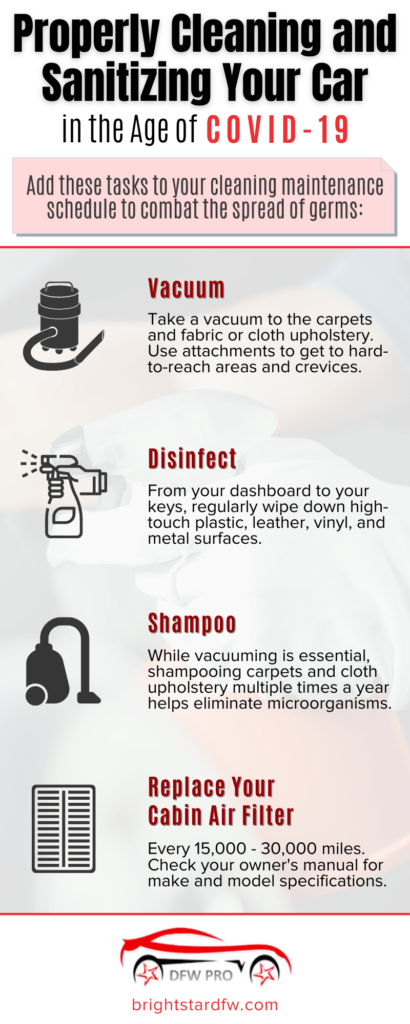The average American spends nearly 11 hours in their car every week. Whether you have a long commute or go on weekend family outings, you likely spend a lot of time in your vehicle.
Keeping your car clean has always been important, but now in the age of COVID-19, it has become crucial to ensure you and your family’s health. Germs can hide in many areas of your vehicle:
Carpets and Upholstery
Just like in your home, carpets can be harbingers of countless germs. Crumbs, dust, and dirt can find their way into the porous design of many carpets and upholstery. Inadequate cleaning of your car’s carpets, mats, and upholstery can leave a litany of dangerous pathogens.
High-Contact Areas
Your car is filled with areas that are considered high-contact locations. High-contact locations are any part of the interior that is touched by you or your passenger. This includes your steering wheel, shifter, dashboard, door handles, HVAC controls, and touch screens. These areas are especially prone to contamination as they are being touched on a constant basis.
Cabin Air Filter
Most modern vehicles employ a cabin filter to properly clean the re-circulating air from the car’s HVAC system. These filters can significantly reduce the spread of germs, mold, pollen, and dust. However, a dirty air filter will not be able to adequately do its job, leading to the spread of unnecessary pollutants inside your car.
Car Keys
Although not technically a part of your car’s interior, your car keys can be a gateway for the spread of dangerous microbes. Not only do you frequently handle them, but your keys are often placed on dirty surfaces, continually exposing them to germs.
Germs Found Inside Vehicles
From your carpets to your steering wheel, pathogens can flourish inside a dirty vehicle. Here are just some of the microorganisms that can be found in a car:
- Mold spores
- Allergens
- Intestinal pathogens such as norovirus, salmonella, and escherichia coli
- Cold and flu viruses
- COVID-19
The Best Defense Is a Good Offense
There are multiple preventative measures you can take to prevent the contamination of your car’s interior.

Vacuum
Your vehicle’s interior should be vacuumed at least once a month. This includes cleaning the carpets and the upholstery if it is made of fabric or cloth. Brush attachments and a crevice tool should be used to get to hard-to-reach areas where germs can lurk.
Disinfect
Many harmful pathogens can survive for weeks on hard surfaces, such as plastic, leather, vinyl, and metal. It is essential to wipe down high-touch surfaces as often as possible to reduce the spread of germs. As we previously mentioned, these surfaces can include your dashboard, door handles, touch screens, HVAC controls, cup holders, and car keys.
Shampoo
Even regularly scheduled vacuuming cannot remove all the germs that may accumulate in your vehicle’s interior. That is why it is vital to shampoo your carpets and cloth upholstery several times throughout the year. Shampooing these areas will eliminate any microorganisms that may not have been removed during vacuuming.
Replace Your Cabin Air Filter
It is important to replace your cabin air filter per your vehicle manufacturer’s guidelines. If you are unable to change the filter yourself, most auto repair mechanics can perform this task for you.
Here at DFW Pro Bright Star, we are dedicated to providing you with the highest level of service and professionalism. We employ certified technicians that are able to properly address the problems our customers may encounter. For more information about our collision repair services, please contact us today.
